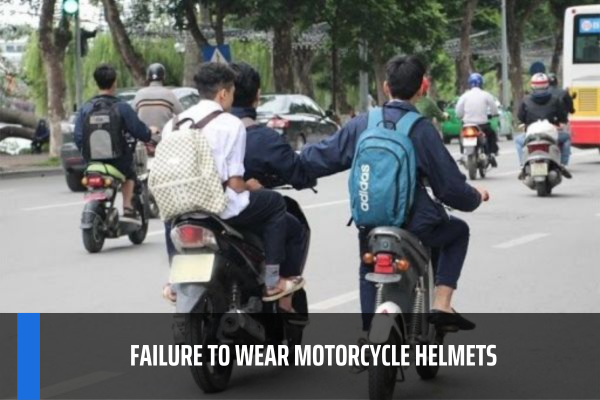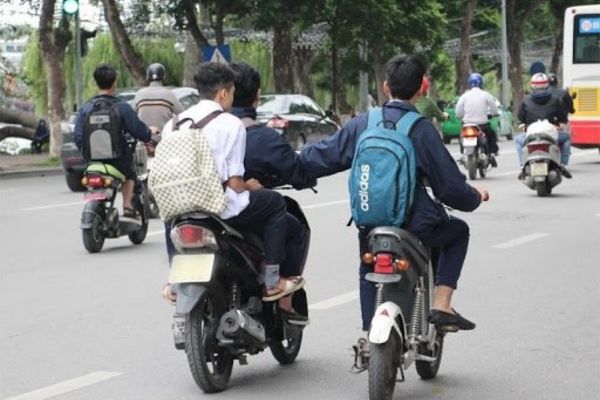How much is the fine for failure to wear helmets when operating motorcycles in Vietnam? Will the operators be taken records for failure to wear motorcycle helmets?
- How much is the fine for failure to wear helmets when operating motorcycles in Vietnam?
- Vietnam: Will the operators be taken records for failure to wear motorcycle helmets?
- Vietnam: What information must administrative violation records contain?
- What are the procedures for traffic police control in Vietnam?
How much is the fine for failure to wear helmets when operating motorcycles in Vietnam?
Pursuant to the provisions of Clause 3, Article 6 of Decree 100/2019/ND-CP supplemented by Point b, Clause 4, Article 2 of Decree 123/2021/ND-CP, the provisions are as follows:
Penalties imposed upon operators of mopeds and motorcycles (including electric motorcycles) and the like violating road traffic rules
...
3. A fine ranging from VND 400,000 to VND 600,000 shall be imposed upon a vehicle operator who commits any of the following violations:
...
n) Failure to wear a motorcycle helmet properly or wearing it improperly;
o) Carrying a person who does not wear a motorcycle helmet or does not wear the motorcycle helmet properly, unless that person is a patient who needs urgent medical care, a child under 06 years of age, or a criminal being escorted.
Thus, based on the above regulations, the act of failure to wear a motorcycle helmet properly or wearing it improperly will be fined from 400,000 VND to 600,000 VND.

How much is the fine for failure to wear helmets when operating motorcycles in Vietnam? Will the operators be taken records for failure to wear motorcycle helmets? (Image from the Internet)
Vietnam: Will the operators be taken records for failure to wear motorcycle helmets?
Pursuant to the provisions of Clause 1, Article 56 of the Law on Handling of Administrative Violations 2012, it is stipulated as follows:
Administrative sanction without record taking
1. Administrative sanction without record taking is applicable in cases of warning or fines of up to VND 250,000 for individuals, VND 500,000 for organizations and the persons with sanctioning competence must make decisions of administrative sanctions on the spot.
In case administrative sanctions are detected thanks to using technical, professional equipment, means, the record must be taken
...
Motorcycle operators who fail to wear motorcycle helmets shall be imposed fines ranging from VND 400,000 to VND 600,000.
Thus, based on regulations, if motorcycle operators commit traffic violations of failure to wear a motorcycle helmet, the persons with sanctioning competence must make decisions of administrative sanctions on the spot.
Vietnam: What information must administrative violation records contain?
Pursuant to the provisions of Article 58 of the Law on Handling of Administrative Violations 2012, amended by Clause 29, Article 1 of the Law on Amendments and Supplements to certain Articles of the Law on Handling of Administrative Violations 2020 stipulates as follows:
Making records of administrative violations
...
3. An administrative violation record must contain the following main information:
a) Recording time and venue;
b) Information about the record maker, violating person or entity, individuals or entities involved;
c) Time and location when and where the violation occurs; case or violation description;
d) Testimony of the violator or representative of the violating entity, the witness, the victim or representative of the organization suffering loss or damage;
dd) Injunction and guarantee measures;
e) Rights and duration of explanation.
...
Accordingly, the administrative violation record includes the main information mentioned above.
What are the procedures for traffic police control in Vietnam?
Based on the regulations in Article 18 of Circular 32/2023/TT-BCA on the procedures for traffic police control, the process is carried out in the following steps:
Step 1: Request the driver to take safety measures and stop the vehicle.
Step 2: Greet the individual according to the People's Police regulations (except when there is prior knowledge of criminal behavior, catching in the act of committing a crime, or an arrest warrant). When dealing with individuals who have violated the law, traffic police officers must maintain the correct posture, manners, behavior, and appropriate attitude.
Step 3: Inform the driver and passengers of the reason for the control; request the driver to present relevant documents or information of the relevant documents in the electronic identity account.
Step 4: Carry out control measures according to Clause 2 of Article 12 of Circular 32/2023/TT-BCA, including:
- Control of documents related to individuals and vehicles.
- Control of traffic participation conditions of the vehicles.
- Control of compliance with road transport safety regulations.
- Control of other related content as stipulated by the law.
For vehicles carrying 10 or more passengers or vehicles with equivalent dimensions to those carrying 10 or more passengers, the control and notification of control results must be carried out directly in the passenger compartment.
Step 5: Conclude the control.
The traffic police officer reports the control results to the team leader, informs the driver and passengers of the control results, any violations (if any), and the measures to be taken.
*Note:
When there is reason to believe that individuals, vehicles, or objects involved in traffic have hidden evidence, vehicles, or documents used for administrative violations, a body search and vehicle search may be conducted according to the regulations of the law for handling administrative violations.
In case of detecting signs of a crime, the procedures stipulated by the law on criminal proceedings shall be followed.
LawNet
